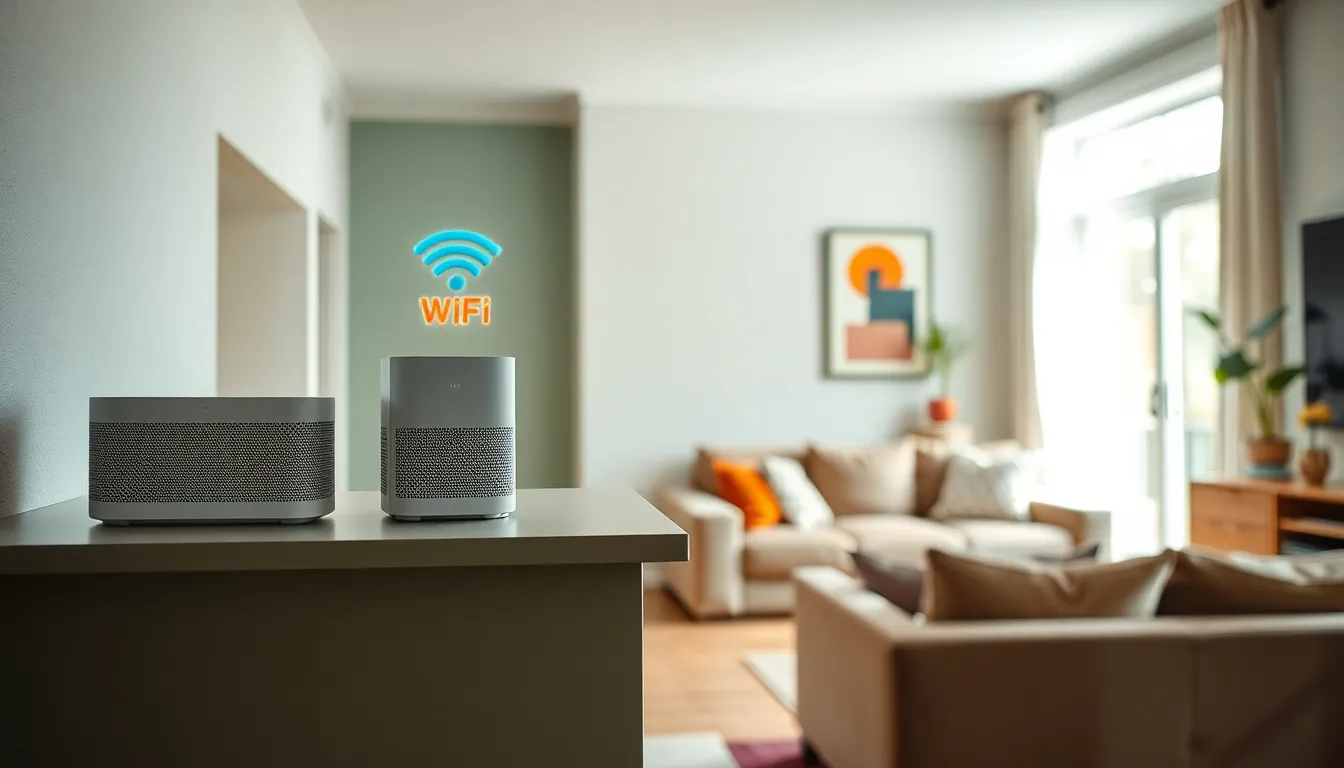In today’s tech-savvy world, having a reliable internet connection is as essential as having coffee in the morning. Enter mesh Wi-Fi systems, the superheroes of home networking. They swoop in to save the day, banishing dead zones and buffering woes faster than you can say “streaming binge.”
Imagine a seamless connection that wraps around every corner of your home like a cozy blanket. Whether you’re scrolling through social media or battling it out in online gaming, the best mesh Wi-Fi systems ensure you stay connected without a hitch. So, if you’re tired of the Wi-Fi struggle and ready to embrace the future, it’s time to explore the top contenders that’ll transform your internet experience from “meh” to magnificent.
Table of Contents
ToggleOverview of Mesh WiFi
Mesh WiFi systems provide comprehensive coverage throughout large spaces, ensuring consistent connectivity in every corner of the home. They consist of multiple units that work together, creating a single, unified network rather than several distinct access points. This technology minimizes dead zones, allowing devices to maintain strong signals without interruptions.
Homeowners often choose mesh WiFi solutions to improve streaming, gaming, and browsing experiences. Increased speeds enhance online activities and make connections faster and more reliable. For example, while streaming 4K videos or hosting video calls, users benefit from uninterrupted access.
Using mesh WiFi, devices can switch seamlessly between nodes, optimizing performance based on location and load. Amazon, Google, and Netgear are renowned brands offering various models with high user satisfaction. These brands focus on easy installation and management through companion apps.
Additionally, many mesh WiFi systems include advanced features like parental controls and security settings, providing peace of mind for families. Connectivity strength depends on proper placement; units should be spaced to maximize coverage without interference.
In challenging layouts, such as multi-level homes, mesh systems excel at delivering strong signals despite structural obstacles. The flexibility of adding extra units as needed allows for customizable network setups. With so many options available, selecting the best mesh WiFi system can significantly enhance online experiences.
Top Features to Consider


Selecting a mesh Wi-Fi system requires careful consideration of several key features that significantly affect performance and usability.
Coverage Area
Coverage area determines how well the mesh system can eliminate dead zones within a home. Large homes benefit from systems designed to cover square footage ranging from 3,000 to 6,000 square feet. Performance varies among brands; therefore, understanding the specifications can help in choosing the right model. Installation of additional units can enhance coverage, especially in multi-level environments or spaces with structural obstacles. Users often find that strategically placing nodes improves signal strength, allowing for seamless internet access in every room.
Speed and Performance
Speed and performance affect how well devices connect and communicate. Look for systems that support Wi-Fi 5 or Wi-Fi 6 standards, as these ensure faster internet speeds and lower latency. Many systems boast speeds exceeding 1 Gbps, which is essential for activities like gaming or streaming in 4K. System performance is not solely based on speed; maintaining a stable connection across devices is equally important. Brands prioritize adaptive routing, enabling devices to switch nodes for optimal performance based on current load.
Device Compatibility
Device compatibility plays a crucial role in user satisfaction. Most mesh systems support various devices, from smartphones and tablets to smart home gadgets. It’s essential to check compatibility with both older and newer devices to prevent connectivity issues. Many systems incorporate backward compatibility, ensuring reliable performance with legacy devices. Some setups provide easy integration with smart home ecosystems, enhancing control over connected devices. Users often appreciate systems that allow multiple devices to connect without a dip in performance.
Best Mesh WiFi Systems in 2023
Exploring the best mesh Wi-Fi systems enhances internet experiences. Here’s a look at top options available this year.
System A Review
Amazon’s Eero Pro 6 stands out with its Wi-Fi 6 capabilities. This system covers up to 6,000 square feet with multiple nodes. Homeowners appreciate its simple setup via the Eero app. Performance remains strong even with multiple devices connected simultaneously. Advanced security features help protect user data. Priced around $599, this option meets the needs of gaming and streaming enthusiasts. User satisfaction highlights this system’s reliability and speed, making it a top choice for large homes.
System B Review
Google Nest Wifi excels in design and functionality. Offering up to 4,400 square feet of coverage, it delivers solid performance for everyday internet use. Users enjoy intuitive installation through the Google Home app. The system supports smart home integrations, enhancing the overall experience. Additionally, parental controls enable oversight of children’s online activities. Available for about $299, this mesh solution appeals to families looking for ease of use. High ratings reflect its reliability and sleek aesthetics.
System C Review
Netgear Orbi RBK852 provides impressive speed with Wi-Fi 6 technology. Capable of covering 5,000 square feet, it’s perfect for larger spaces. The Orbi app simplifies installation and management of devices. Users benefit from tri-band technology, optimizing connections across devices. Advanced security features contribute to a safer online environment. Priced around $699, this option suits high-performance needs. Positive reviews emphasize its robustness and exceptional coverage.
Installation and Setup Process
Setting up a mesh Wi-Fi system involves a few straightforward steps. First, users should unbox all units, ensuring everything needed is included. Typically, these systems come with a main router and one or more satellite nodes.
Next, it’s important to place the primary router near the modem for optimal connectivity. Then, users can position the satellite nodes in areas that require improved coverage, ensuring they aren’t too far apart. A good rule of thumb is to keep each node within a reasonable range to maintain strong communication.
After positioning, users must connect the main router to the modem using an Ethernet cable. Many systems come with mobile apps that guide users through the process. Installing the companion app allows for easier management of the network and provides helpful tips for node placement.
Upon completing the physical setup, users can power on the units. The app will typically lead through the configuration process, allowing users to create a network name and set a password. It’s crucial to follow all on-screen instructions for a successful installation.
Once set up, the mesh system automatically establishes a single network, making it easy for devices to connect seamlessly. Users benefit from features like automatic updates and network optimization through the app, ensuring the best performance.
These systems often allow for adding extra nodes easily, enhancing coverage when needed. Regular checks through the app can help monitor performance and manage devices connected to the network.



